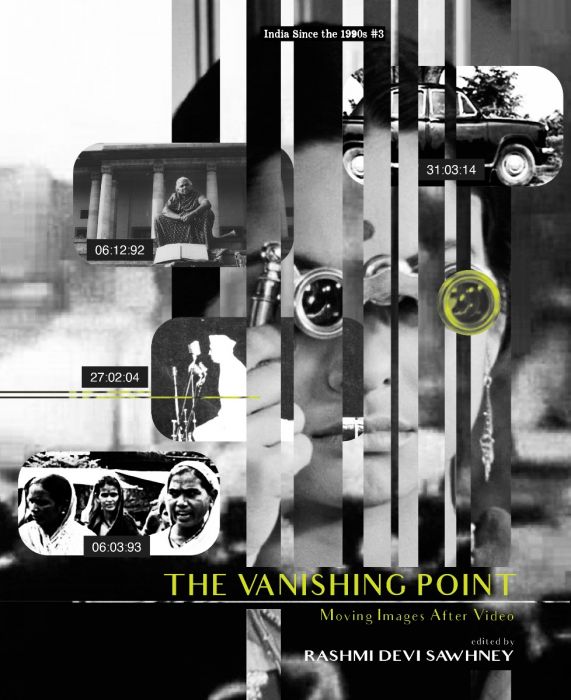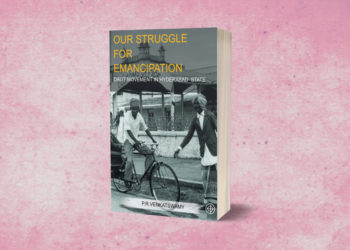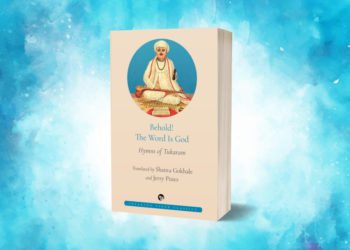The Vanishing Point: Moving Images After Video (Tulika Books) (volume 3 in the India Since the 90s series) tracks the fugitive afterlife of the moving image ever since the proclaimed death of celluloid film. At once everywhere and nowhere, rapidly circulating moving images have become archives of public memory, degraded repositories of what was cinema, surveillance tools and instruments of governance. In this book, filmmakers, moving image artists and theorists are assembled to reconstruct one of the most elusive, and significant, transformations of the millennial turn.
India Since the 90s (general editor: Ashish Rajadhyaksha) is a series of six titles exploring recent history from the standpoint of the present moment. As we face new and unprecedented phenomena in the twenty-first century, along with the new, there is also a ghostly re-evocation of things we have seen and done that relentlessly suggest that we may have been here before. Familiar forms and arguments become curiously prescient revealing new relevance. This series includes texts and images from diverse academic disciplines, curated and assembled by practitioners looking back to reconsider our past.
The following is an excerpt from the book.

The repression, censorship and political excesses of the Emergency which was declared in 1975 further strengthened these movements and the volume of related discussions. The dominant idea was that a people’s cinema was needed – a complete rejection of the government; and although this also happened in the parallel fiction cinema of the time, it happened faster in documentary (because, perhaps, fiction films were also made with state funding, unlike documentaries). What began to emerge amongst the films made in the context of these discussions was a template, an idea of a ‘correct’ style of filmmaking, which would function as ‘the voice of the people’.
To quote the filmmaker Deepa Dhanraj from an early 1990s interview:
“We saw films as a way of documenting and expressing a certain thinking. Why we chose films specifically as the medium as opposed to the theatre, we really were not clear about. We were unhappy with the films around us and we did feel the need to reach out and generate images to counter the negative portrayals in the media. India having such a strong audience tradition, films seemed to be a good medium to enable us to go into community and draw people together. That we were not going to screen these films to a neutral audience was very clear, so our audience was fixed. The whole process was an alliance with the people who helped us to make the film. So both in production and conception, the themes and concerns of these films originated with the activists of that area.”
This desire to be ‘the voice of the people’ created, in a sense, a new kind of selfless film. Usually, it meant that the film contained no commentary or a very bare commentary, and used instead interviews with affected communities or sometimes their leaders in order to transmit a clear message without ambiguities and confusion. The notion of the individual subjective filmmaker, or individual subject, was strongly rejected, and films now had to be about collective identities at all times – although these identities were not as amorphous as the ‘Indian’ identities of FD films. Rather, they were now marginalized voices and identities. There were several heated debates around this issue over the years during which this new form was endorsed, one which was keen to mask the idea of an individual speaking the film, and discouraged quite openly any experimentation or the introduction of filmmaker subjectivities as being, to put it crudely, a bourgeois indulgence or, in the Indian context, Brahminical (upper-caste) approaches.
To quote Deepa Dhanraj from the same interview again:
In India, what has also happened is that we have got stuck with the form of socialist realism without the environment of revolution which bred this form in the first place . . . (as in say Chile, or the USSR. . . . Many film forms created (in those contexts) have become radical genres which ‘political’ filmmakers have used and are still using in toto. Here in India, the prevailing ideological climate is reactionary and we seem to have got stuck with these forms without the specific historical circumstances that bred them in the first place. Today, by and large, these films only illustrate the individual film-maker’s politics and don’t move into the realm of political activity.
One could restate Dhanraj’s comments to say that there was a performance of liberalism that was being carried out through the act of making a certain documentary, and there was high anxiety in stepping away from this performance for fear of seeming unqualified to speak in this process of what the nation should be or how it should be, and perhaps of revealing and unmasking an identity of privilege. This absence of the ‘I’, however, allows for a fixed performance from the subject, the filmmaker and the audience, who also proceed along fixed lines of victimhood, fervour, anger or indignation. Therefore, for instance, the only way a filmmaker can prove he or she is ‘secular’ and so authorized to speak about this subject is by constantly speaking about communalism in his or her films. Similar paradoxes prevailed for feminism and issues of caste. In these sometimes radical, and sometimes supposedly radical films, too, there is no presence of the ‘I’ from the filmmaker’s perspective – who is supposedly a revolutionary – nor from that of the subjects’, the revolutionary oppressed who, in fact, express themselves as ‘we’.
In the post-liberalization 1990s, with the falling away of many of these movements, documentary film practice underwent a huge transformation. In response to a very fragmented political context, and correspondingly a fragmented context of circulation, where the usual audiences for documentaries – those who identified with certain movement politics and organizations – were now dispersed, Indian documentary practice underwent an upheaval and a proliferating experimentation. This period resulted in diverse simultaneous practices. An overall acceptance of the subjective in documentary and the personal in filmmaking produced the presentational work of Mani Kaul, the personal essay films of Ruchir Joshi, and later, the political essay films of Amar Kanwar; the use of intimate biographies as history by Reena Mohan and Sameera Jain; films incorporating theatrical performance and the theatre of performance by Madhusree Dutta – to name just a few styles that emerged.
It may be too much of a simplification to say that the earlier forms of filmmaking, which were impatient with the ideas of subjectivity and intimacy, and even of ornamentation, were more masculinist styles. While an overwhelming number of documentary practitioners and theorists have been men, women have certainly practised documentary in this way as well. But what is discernible is that, many of the shifting approaches to documenting reality did come from feminist theory and discussion: the re-examination of modes of power in conversation/ interview, the idea of oral histories, a comfort with personal viewpoints and approaches, all of which, while easily accepted in the practice of art itself, have always been a matter of unease in the world of documentary practice. In fact, a number of schisms along these lines – how to define what is political or worth taking seriously in political activism – did take place within the world of organizational left politics through the 1980s and 1990s. During these decades, feminists broke away from Marxist groups, Dalit feminists challenged the feminist movement on its non-reflexivity vis-à-vis caste or religion, and sexuality movements challenged other movements on account of heteronormativity and prudery. These upheavals of discussion around the idea of political tone led to the many new approaches that began to emerge in Indian documentary practice.
While these approaches are diverse, they have collectively achieved a strong breakthrough: no longer do we make films in terms of a fixed reality; there is a recognition that often the subject performs an aspect of themselves for an aspect of you, the filmmaker at the time; there is also an incorporation of this element of mutual performativity into the form of the film and its claims to reality and truth. In these films, the first person is sometimes stated, and sometimes implicit. This ease has brought in its wake fresh anxieties. During the 2000s, practitioners have become more comfortable with the idea of documentary as creative endeavour, one where there can be formal excellence or experimentation along with political engagement – in fact, a somewhat opposite movement to the idea that roughness in form signals authenticity of politics, or discussions which privilege unedited material as having more revolutionary resonance. However, this development has not always been a perspective that those funding documentary have unequivocally shared.
Till today, in fact, a large amount of funding sources for the documentary, with very few exceptions, remain tied to a programmatic agenda. For a film that does not fall into an interpretation of that agenda, funding often has to be sought from outside India. Thus, a significant number of documentaries are now funded by European, British and, to a lesser extent, US broadcasters. Interestingly, there is a preference and encouragement here for the use of the first person in the narration of these films. The use of the ‘I’ happens here within a very different programmatic context. Foreign commissions often ask for a ‘compelling personal story’ following a single character and placing the filmmaker as an ‘I’ looking for a personal connect, an emotional story. The ‘I’ of this narrative is not a complicated one, but carries in fact with it an uncomplicated notion of intimacy and simplicity. Since these are ‘international stories’ not playing to an informed audience, it is felt that complicated narratives, and idiomatic styles of filmmaking, via the personality of the filmmaker, in which the film embodies the subjectivities of the filmmaker, would make the film impenetrable.
Here, the ‘I’ becomes a sort of eyewitness narrator who simplifies and leads the viewer through the labyrinth of a foreign reality to create a unitariness of narrative and narrator. It displaces the gaze onto a visible point – the fixed narrator – and thereby controls how it is deployed. So the first person becomes an uncomplicated and uninterrogated mask of the self; but also a disingenuous one. The idea that there is personal investment in making a film about anything – a famous female hijacker for a Palestinian immigrant, the exiled Queen of Iran for an exiled Iranian in France, the president of Pakistan for a progressive Pakistani woman, the domestic help for an urban Indian feminist, a little boy in a slum for a compassionately curious observational filmmaker – is one that allows us to elicit intimacy from the subject, for the audience, without necessarily granting it of ourselves, although there are always extraordinary exceptions. Somewhere, this smoothening ‘I’ confirms the political reliability of the narrator, affirms their locus standi to tell us a general story about their culture.
This shifting journey of the first-person pronoun through the history of Indian documentary in many ways tells the changing story of how documentary practitioners strive to be political beings – and to what extent they are able to negotiate the power equation between the subjects of a documentary and the filmmaker/narrator of that documentary. One cannot claim that one way of being political is superior to another, but we do understand that the act of making a nonfiction film carries implications for reality and responses to that reality, which are very different from fictional and abstract forms. It is not, in that sense, a simple act; it is an engagement with the idea of truth and falsehood, good and bad, right and wrong that hopes to influence the public conversation around something.
For me, personally and politically, as a filmmaker and a citizen living in times where we cannot take any political ideas and identities for granted, these engagements and negotiations have largely centred around detailing the kind of ‘I’ who narrates the films I make. My strategy (and I reiterate that I don’t consider it superior to other strategies, just preferable for me. Eventually, the political and creative strategies employed by any filmmaker are also particular to her biographical and aesthetic preferences besides her political intentions) is to create a highly particular narrator, a fictional persona who is unique and not an Everywoman, and who necessarily is a bit unreliable through this peculiarity of being a persona with clear characteristics, prejudices and idiosyncratic expressions. One of the reasons I feel strongly about this element is because, while I’m not against seductive pleasures in a film for the audience to enjoy itself – in fact, I feel this enjoyment can be a trustworthy guide, something that encourages the viewer to trust their instinct and judgement rather than that of the narrator; put them in the mood, so to say – I am suspicious of a seductive ease of understanding, the automatic assumptions of the political categories and values that some themes or issues might carry for audiences.
The idea of a created person, who moreover is a capricious character, strong in personality, overtly performative and hence a bit unreliable, creates, I believe, two dynamics. First, it does not compel the subjects in the film to an obvious personal intimacy with the filmmaker, although there may well be a performative or an intellectual intimacy, and even a public intimacy as in conversation, which is replete with hesitation and doubt rather than assertion. Second, it also demands from those in the audience an intimacy of engagement, with itself but not necessarily with others, because the audience has to rely a bit more on its own sense while watching the film. This demand also arises from the fact that the narrator is obviously an unreliable, prejudiced or half-informed character who is not grounding the viewer, either through a personal claim of having witnessed, or through making the audience a witness through seemingly close observation, but rather leaving the viewer to arrive at some conclusions on their own. By confusing and complicating the ‘I’ in the films, I think I reflect some of Sastry’s discomfort with form turning into a political orthodoxy and thereby proving its value, rather than through the immediate experience and understandings it hopes to provide or catalyze.
At a more specific aesthetic level, I have chosen a voice or persona which emphasizes popular culture, humour and the quality of the trickster as, at first, an intuitive and later, a conscious political response to what I consider a pompous tendency in talking about politics, a paternalistic declamatoriness that is constantly employed to denote seriousness – and thereby dominate the political discourse, designing a disguised elitism. In laughing at this tone that takes itself so seriously, I want to be able to democratize, for want of a better word, how audiences relate to the idea of politics and, in fact, by offering no superior standpoint of experience or knowledge, but only the experience of having watched one person’s film, with its attendant flaws and flourishes, perhaps compel them into political and philosophical reflection. At the risk of sounding paternalistic (or maternalistic), I would say this sort of ‘I’ presents the intimacy of uncertainty and gives the audience a certain self-confidence with which to engage in the political. I believe these forms of the personal and the popular tap into existing vernacular audience traditions – for instance, of identifying with the trickster, while being aware and alert that she might, at any time, turn her laughing gaze upon you and involve the audience in a project of reformulating the terms of the political discussion – but also that they reformulate the idea of the documentarian as an artist, not an activist above art (and, by implication, artifice).
Through these aspects of my practice, I hope to erase earlier divisions – not only those that are about where we must find politics and how it should be presented and, by implication, who is qualified to speak of the political and the way they must speak of it, but also divisions that dictate how documentaries are watched as cultural products. In this revisionism, I dare say that along with many of the filmmakers working through the 1990s and in the contemporary moment, I am also engaged in constructing or reconstructing more indigenous theories of documentary practice and language which might eventually contribute to a more self-sustaining and enlivened (and, from the filmmaker’s point of view, enlightened) funding, creating, viewing and exhibition context than has existed for some time. These formal responses are an acknowledgement of the reality that there are many contending voices in political ideology, and that there is no unquestionable progressive position to be taken. These practices also intentionally cast doubt on the assumed superiority and value-free narrative tendency of an ‘international’ language of documentary, which is essentially a European or an Anglocentric language of documentary.
The watching of a film is eventually a ritual, as so much of it is so publicly experienced. The desire to make films with a fragmented or elusive first person narrator in some ways arises from the desire to interfere with a monotony that sets into a ritual, and to reinvigorate it in the process. But also, in an age where public viewing is increasingly replaced by individual private viewings on computers or TV screens, a heightened awareness in negotiations with the ‘I’ who narrates a film holds the possibilities for a more personal, reflective ritual of watching reality and making sense of it.




